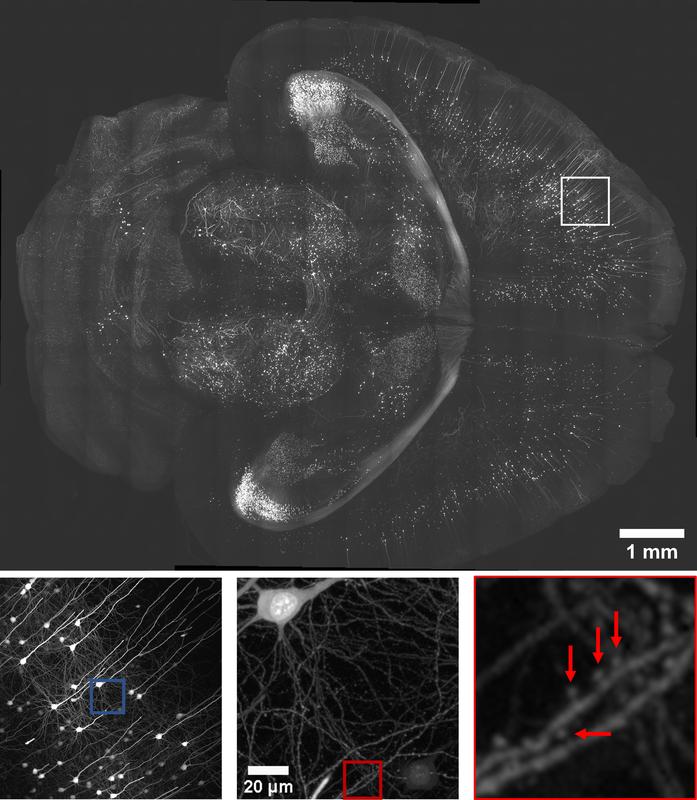Synapses in 3D: Scientists develop new method to map brain structures

An x–y view of a section 2.5 mm from the top surface of a Thy1-eGFP PEGASOS-cleared brain. Close-up of the box with a rendered neuron. Insets provide magnified views of synaptic spines. Reto Fiolka
To make the synapses visible, the research team at Southwestern University Texas, led by Reto Fiolka and Kevin Dean, developed a special microscope. The scientists illuminate a tissue sample approximately one millimeter in size from the side with wedge-shaped focused light. While the focus of this light wedge shifts, image data is recorded.
This enables the researchers to use machine learning to identify and visualize three-dimensional tissue structures within the cells in high resolution and true to scale. Depending on the optical configuration, the microscope provides up to 260 nm of axial resolution, a three to tenfold improvement over confocal and other reported cleared-tissue light-sheet microscopes.
The research team imaged millimeter-scale cleared tissues with subcellular three-dimensional resolution, which enabled automated detection of multicellular tissue architectures, individual cells, synaptic spines and rare cell–cell interactions.
“This work is groundbreaking. The recognition of synapses in millimeter-sized tissue using the light microscope only on the basis of their structure has long been a dream of scientists,” said Rainer Heintzmann from Leibniz IPHT.
He calculated the expected light distribution and thus the quality of the wedge focus. “The calculations are important for the optical design of the instrument,” explains Rainer Heintzmann. “They take into account the unwanted influence that the non-ideal refractive index of the embedding medium has on the quality of the focus. “
The research team believes their method will expedite human cell atlas efforts, providing much- needed insight into how tissue function manifests in health and disease, from the heterogenous cellular populations that compose it. Scientists around the world are working on three-dimensional imaging and characterization of all cells in the human body.
The Human Cell Atlas is intended to create comprehensive reference maps of all human cells to contribute to a better understanding of how fundamental processes in our organism take place and how they change when we become ill, thus helping to enable better diagnosis and treatment.
Prof. Dr. Rainer Heintzmann
Head of the Microscopy Research Department
+49 (0) 3641 · 206-431
rainer.heintzmann(a)leibniz-ipht.de
T. Chakraborty et al., Nature Methods 16, 1109-1113, 2019; https://doi.org/10.1038/s41592-019-0615-4
Media Contact
More Information:
http://www.leibniz-ipht.deAll latest news from the category: Medical Engineering
The development of medical equipment, products and technical procedures is characterized by high research and development costs in a variety of fields related to the study of human medicine.
innovations-report provides informative and stimulating reports and articles on topics ranging from imaging processes, cell and tissue techniques, optical techniques, implants, orthopedic aids, clinical and medical office equipment, dialysis systems and x-ray/radiation monitoring devices to endoscopy, ultrasound, surgical techniques, and dental materials.
Newest articles

NASA: Mystery of life’s handedness deepens
The mystery of why life uses molecules with specific orientations has deepened with a NASA-funded discovery that RNA — a key molecule thought to have potentially held the instructions for…

What are the effects of historic lithium mining on water quality?
Study reveals low levels of common contaminants but high levels of other elements in waters associated with an abandoned lithium mine. Lithium ore and mining waste from a historic lithium…

Quantum-inspired design boosts efficiency of heat-to-electricity conversion
Rice engineers take unconventional route to improving thermophotovoltaic systems. Researchers at Rice University have found a new way to improve a key element of thermophotovoltaic (TPV) systems, which convert heat…



